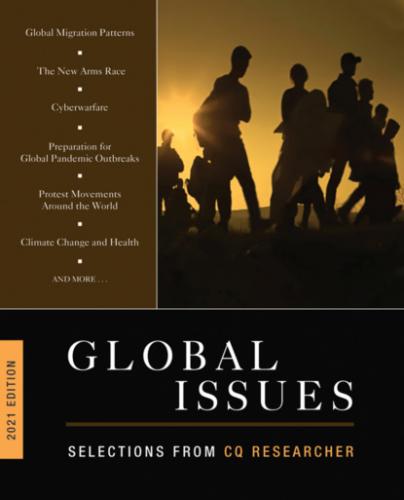A nuclear weapons expert discusses why the New START Treaty should be extended for another five years.
Mohammed, Arshad, and Jonathan Landay, “U.S. Congress pressures Trump to renew arms control pact,” Reuters, Dec. 17, 2019, https://tinyurl.com/wen3v52.
Two reporters detail lawmakers’ concerns that President Trump may let the New START Treaty expire next year.
Moniz, Ernest J., and Sam Nunn, “The Return of Doomsday,” Foreign Affairs, September/October 2019, https://tinyurl.com/yyxqquhl.
Former Energy secretary and a former Democratic senator who is a nuclear nonproliferation advocate detail how the arms control regime constructed over 50 years has unraveled.
Sanger, David E., and William J. Broad, “To Counter Russia, U.S. Signals Nuclear Arms Are Back in a Big Way,” The New York Times, Feb. 4, 2018, https://tinyurl.com/ybufvz59.
Two reporters detail the Trump administration’s nuclear weapons policies.
Tannenwald, Nina, “The Vanishing Nuclear Taboo? How Disarmament Fell Apart,” Foreign Affairs, Oct. 15, 2018, https://tinyurl.com/wj679gl.
A Brown University expert on nuclear policy examines how arms control has withered during the Trump administration.
Reports
“2018 Nuclear Posture Review,” Office of the Secretary of Defense, 2018, https://tinyurl.com/yc7lu944.
The Trump administration lays out its nuclear weapons policy, which includes waging limited nuclear war with tactical nuclear weapons.
Gleason, Michael P., and Luc H. Riesbeck, “Noninterference with National Technical Means: The Status Quo Will Not Survive,” Center for Space Policy and Strategy, Aerospace Corporation, April 2019, https://tinyurl.com/uqgs2v9.
Two experts in the military uses of space explain the challenges facing U.S. satellite surveillance of Russia’s nuclear arsenal if the New START treaty expires in 2021.
Harrison, Todd, et al., “Space Threat Assessment 2019,” Center for Strategic and International Studies, April 2019, https://tinyurl.com/qulgrwm.
Space war experts detail the weapons other countries have or are developing to counter U.S. military dominance in space.
Hruby, Jill, “Russia’s New Nuclear Weapon Delivery Systems,” Nuclear Threat Initiative, November 2019, https://tinyurl.com/rn7ux3k.
A nuclear weapons expert describes Russia’s new lines of hypersonic boost-glide vehicles, nuclear-powered torpedoes and other systems to deliver nuclear warheads.
The Next Step
China’s Weapons
“China displays new hypersonic nuclear missile on 70th anniversary,” Al Jazeera, Oct. 1, 2019, https://tinyurl.com/y5s958ew.
China unveiled a new weapon believed to be capable of breaching all existing U.S. anti-missile shields.
Chan, Minnie, “China nuclear missile development steps up a gear with test of weapon capable of hitting US mainland,” South China Morning Post, Jan. 4, 2020, https://tinyurl.com/t93cf64.
China tested a new submarine-launched nuclear missile capable of hitting the continental United States.
Wainer, David, “Chinese nuclear plans cloud prospects for new U.S.-Russia missile deal,” Bloomberg, Oct. 18, 2019, https://tinyurl.com/svlbdfn.
China plans on rapidly expanding its nuclear arsenal and seems unlikely to join Russia and the United States in an extension of New START, the arms control accord that is due to expire in early 2021.
New START
Arkhipov, Ilya, “Russia Says U.S. Silence on Last Nuclear Treaty May Be ‘Fatal,’ ” Bloomberg, Aug. 26, 2019, https://tinyurl.com/y3pxf9hx.
A Kremlin spokesman raised concerns about the lack of controls on nuclear weapons if New START, the arms reduction treaty signed by the United States and Russia in 2010, is allowed to expire.
Brennan, David, “America is Risking a Nuclear ‘Free-For-All’ By Delaying New START Extension With Russia: Former National Security Official,” Newsweek, Jan. 16, 2020, https://tinyurl.com/uy6wpzu.
A White House National Security Council staffer during the Obama administration is concerned that delaying, even for a short time, the extension of New START will create long-term security risks for the United States.
Zengerle, Patricia, “Senior U.S. official: Russia in compliance with New START weapons treaty,” Reuters, Dec. 3, 2019, https://tinyurl.com/vc3tmgt.
A top U.S. State Department official said Russia remains in compliance with New START, even as it fails to comply with most other arms control obligations.
Space
Erwin, Sandra, “Pentagon report: DoD needs to test how satellites would perform under attack,” Space News, Feb. 1, 2020, https://tinyurl.com/svf8zaw.
In a new report the Pentagon warns that the U.S. military currently cannot assess the durability of its satellites if they came under attack.
Kiang, Charlotte, “What Exactly Is The Space Force?” Forbes, Jan. 27, 2020, https://tinyurl.com/wf69cw4.
The recently established U.S. Space Force’s work includes procuring and operating space vehicles and satellites and rockets to launch them into orbit.
Strout, Nathan, “What we know about Iran’s counter-space weapons,” C4ISRNET, Jan. 8, 2020, https://tinyurl.com/rfxlvc4.
While it is unlikely that Iran has strong anti-satellite weaponry, defense experts believe the Islamic Republic can jam U.S. satellite communications and GPS.
Tactical Weapons
Brumfiel, Geoff, “U.S. Has Deployed New, Small Nukes on Submarine, According to Group,” NPR, Jan. 29, 2020, https://tinyurl.com/vb4xctn.
A U.S. submarine has begun carrying one or two low-yield nuclear warheads, according to the Federation of American Scientists.
Ioanes, Ellen, and Dave Mosher, “A terrifying new animation shows how 1 ‘tactical’ nuclear weapon could trigger a US-Russia war that kills 34 million people in 5 hours,” Business Insider, Jan. 23, 2020, https://tinyurl.com/yyrqpfta.
A simulation from Princeton University shows how the use of one tactical nuclear weapon could lead to a worldwide nuclear conflict.
Meier, Lauren, “Putin to develop new ‘tactical’ nuclear missiles after Trump spikes weapons treaty,” The Washington Times, Sept. 5, 2019, https://tinyurl.com/vwxhy7m.
After the United States abandoned the Intermediate-Range Nuclear Forces (INF) Treaty in August 2019, Russia said it planned to develop short-range tactical nuclear weapons.
For More Information
American Enterprise Institute, 1789 Massachusetts Ave., N.W., Washington, DC 20036; 202-862-7177;
